Buying your first scuba regulator is a symbolic act. The act signifies that you are no longer part of the one-time-a-year diving club. He who owns his own regulator is clearly something of a more serious diver; and the more serious diver demands quality. A regulator should be prepared for multiple challenges, including but not limited to: increased hydrostatic pressure, near-freezing temperatures, increased inhalation resistance, and contaminated water conditions. By reading our product recommendations and our detailed buyers guide, you will be able to make an informed decision on picking the best scuba regulator for you.
Best Scuba Diving Regulators Reviewed
#1 – Apeks MTX-RC (The Workhorse)
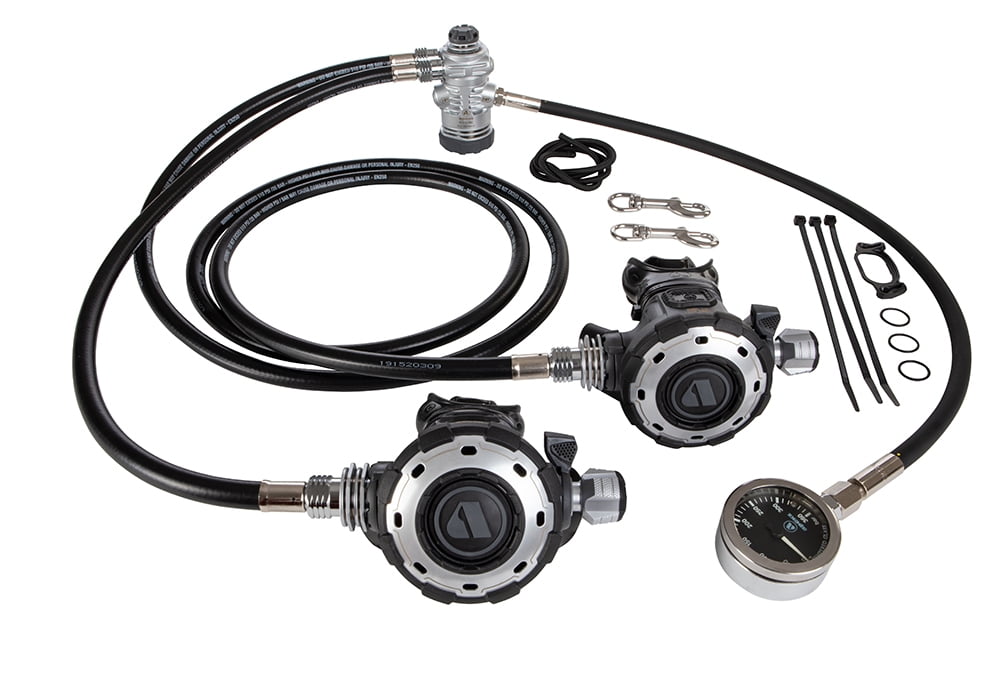
Apeks newest model, the Apeks MTX-RC stands to be one of the toughest, most versatile regulators on the market. The over-balanced diaphragm results in gas flowing to the hoses at a rate higher than the ambient pressure when descending, causing increased performance and low work of breathing. The first stage has 5 low pressure ports, 4 of which are mounted on a swivel turret, and 2 angled high pressure ports, resulting in optimum hose routing. The MTX-RC can be used in all diving configurations, from single tank, to twinset, to sidemount, in water conditions near-freezing. The only downside to this regulator is its high price. The specific MTX-RC set as shown in the picture above comes in a long-hose primary/necklaced short hose alternative setup, however, it is available in the ‘traditional’ setup, as well as in a sidemount setup too.
#2 – Scubapro MK-25 Scuba Regulator (The All-Rounder)

The Scubapro MK-25 stands to be a tried and tested regulator that is favoured among many divers of all experience levels. Its design, with a swivel turret and 5th low pressure port, allow it to be used in all configurations, from single tank to twinset to sidemount. The benefit of such is that this is a regulator that will last you throughout all your diving endeavours. Utilising a piston system in the first stage, the MK-25 provides excellent airflow at all depths.
#3 – Apeks ATX40 (The Cost-Effective)
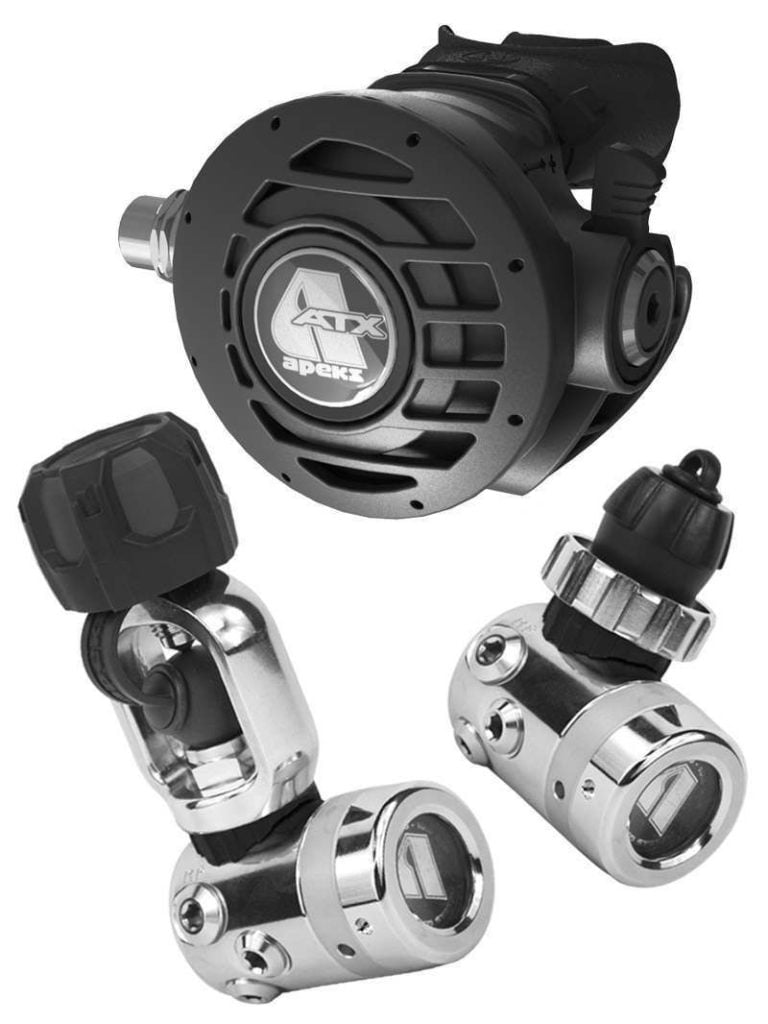
The Apeks ATX40 was the model before the XTX series of regulators. The ATX with DS4 first stage is a regulator that has stood the test of time and is probably one of the most popular regulators on the market, especially among technical divers. It is a very tough, simply designed, environmentally sealed regulator, again with the over-balanced diaphragm. This is a regulator that can withstand the toughest and coldest of environments. And, to top it all off, as it is an older model, it is extremely cost-effective, and is a very affordable option for all divers.
#4 – Halcyon H-75p Single Tank Set (The Go-Getter)
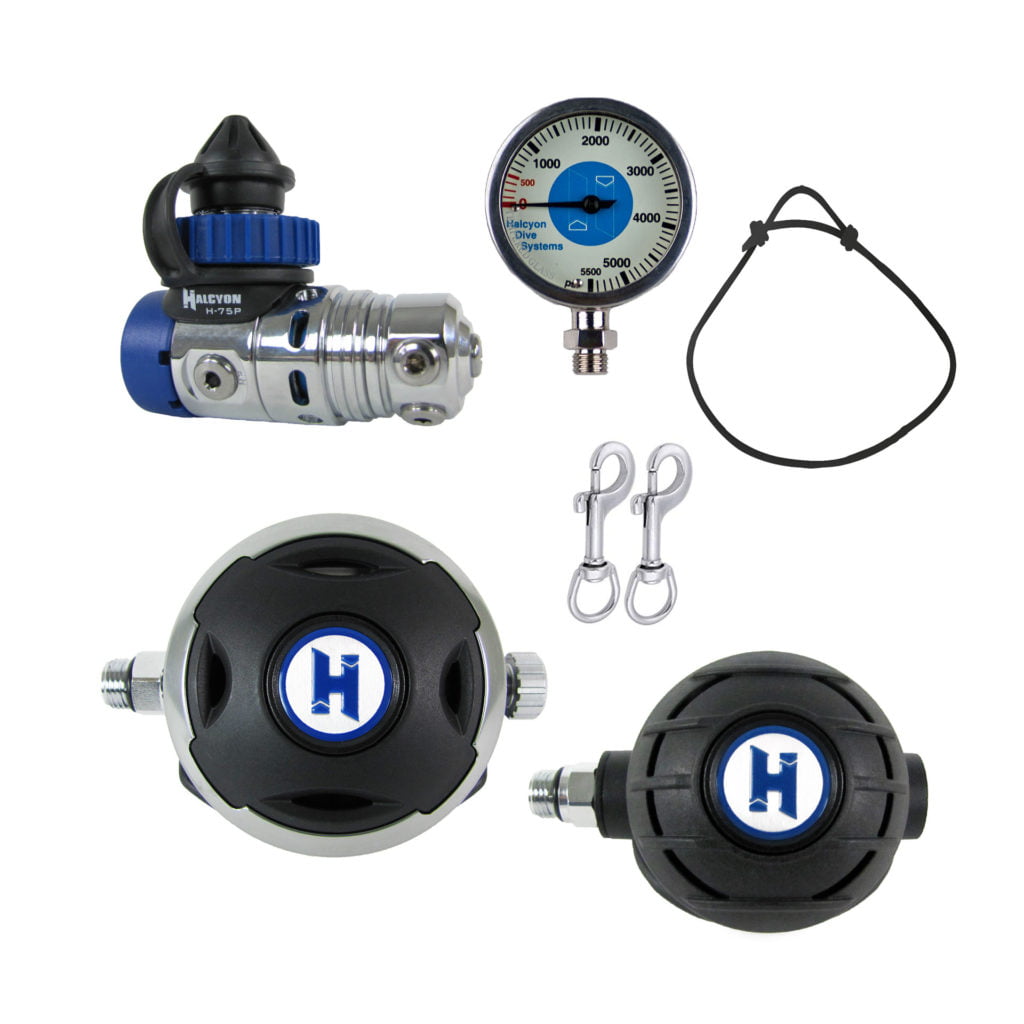
Halcyon is a leading equipment brand, sported by some of the most advanced exploration divers of today. The H-75p Single Tank regulator setup is perfect for the diver who wants a quality, reliable regulator for single tank backmount diving, but who may also move into other types of diving in the future. The swivelling turret makes for many different hose routing options, allowing you to customise it fully to your needs and wants.
#5 – Apeks XL4 Scuba Diving Regulator (The Traveller)
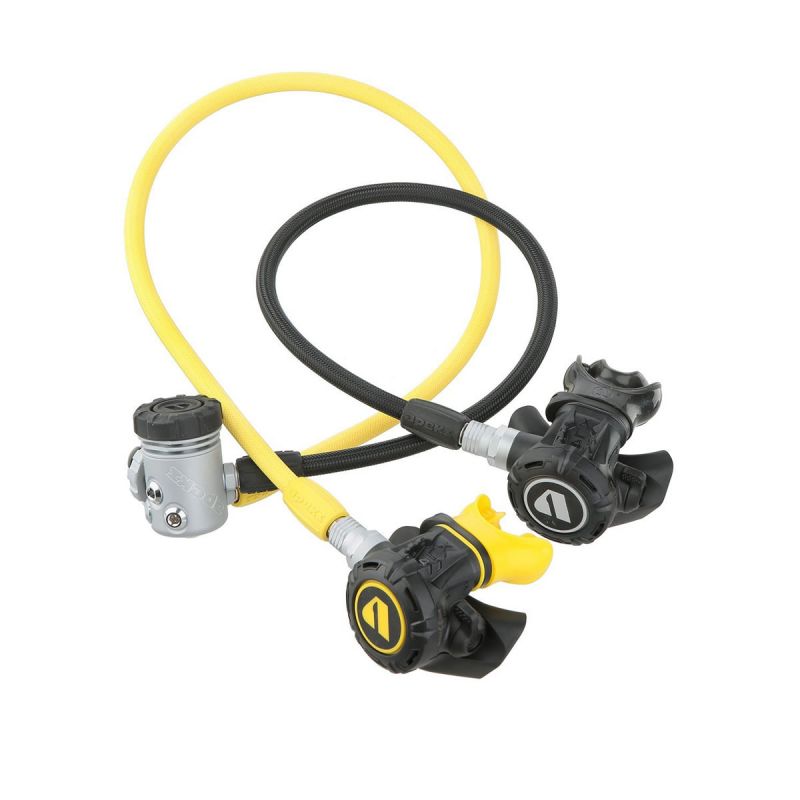
Apeks’ XL4 regulator offers the best of all worlds. It is a regulator designed specifically for the demands of cold-water technical divers. It is environmentally sealed with an over-balanced diaphragm, but that is just the beginning of the technology behind this durable piece of equipment. What makes the XL4 stand out compared to others of the Apeks line is the fact it is extremely lightweight and small. This makes the XL4 perfect for travelling, be it for the new open water diver or the experienced technical diver.
Buyer Guide
What’s in a Scuba Regulator?
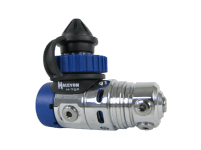
The name scuba regulator is a bit of a catch-all term for a piece of equipment composing multiple parts. When we talk of scuba regulators, and of buying regulators, we are referring specifically to the first stage and the second stage of the regulator.
The first stage of a regulator, as seen on the left, has one primary job: to convert high pressure gas from the tank to an intermediate pressure. This intermediate pressure gas is then fed to the hoses coming off the first stage, connecting to the low pressure inflator hose, the pressure gauge, and the second stage. The job of the second stage is to convert intermediate pressure gas to ambient pressure, so that it is breathable at any given depth. The second stage is simply the mouthpiece that we breathe from, as seen on the right. When you purchase a regulator, you usually get a regulator ‘set’. A regulator set normally includes a first stage, two second stages, a pressure gauge, and a hose for each of these components, as seen below.
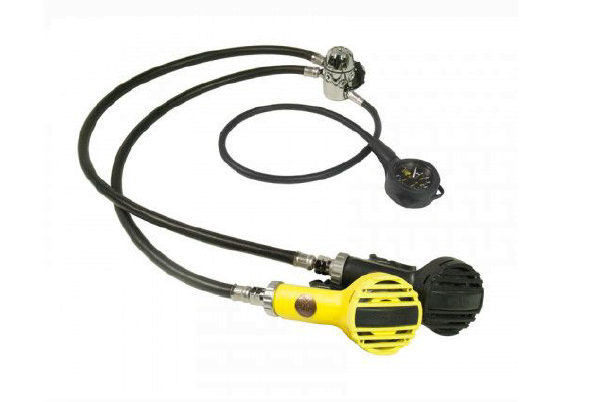
The low pressure inflator hose almost always comes with the BCD, not the regulator. If you want to buy your own regulator but not a BCD, it is perfectly possible to buy the inflator hose separately. Just ensure that the fitting is correct before purchasing. Similarly, some regulator sets come in a more technical style setup, with a long primary hose, and a short alternative air source hose on a bungee necklace. This is becoming a more and more popular option among recreational divers too, as well as already being the de facto standard in technical diving. However, if you do not feel comfortable or simply prefer to dive on a ‘traditional’ setup (with a short primary and slightly longer alternative hose), then you can simply buy the hoses you wish for and swap them out with the longer ones. This comes with the safety proviso that, if you have never swapped out regulator hoses before, then you should do so under the watchful eye of someone who knows how to. Alternatively, if that all sounds like too much work, then you can simply buy a setup that comes with the hose lengths you want.
You may also be interested in the best drysuits or the best scuba diving compasses
Balanced or Unbalanced?
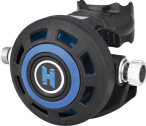
Balanced and unbalanced are terms you are likely to come across in your hunt for the perfect regulator. The concept behind these two terms is simple yet important. Throughout the duration of a dive, our tank pressure, i.e. the amount of breathing gas we have, gradually decreases. With a balanced regulator, this reduction in tank pressure will have no noticeable effect on breathing resistance, with 200 bars breathing just as easy as 20 bars. Conversely, with an unbalanced regulator, the regulator itself uses the tank pressure to aid gas delivery. Therefore, as tank pressure decreases, breathing resistance will increase noticeably. Almost all manufacturers of tough, reliable regulators with a low work of breathing are utilising a balanced system. Although some may argue that an unbalanced regulator is perfectly fine for the shallow water recreational diver, the fact is that it is an inefficient system which limits the diver, and, in cases where an unbalanced regulator is used to dive deeper (but even still within recreational limits), it can present a serious safety hazard. Increased work of breathing can easily increase carbon dioxide retention, which in turn can cause a whole host of dangers, ranging from CO2 narcosis to increased susceptibility to oxygen toxicity. Therefore, it is recommended to stay away from regulators utilising an unbalanced system.
Piston or Diaphragm?
Cavaliers or Roundheads; free will or determinism; Ross or Rachel? Piston or diaphragm is another long-standing debate of our time. And, what makes this debate particularly eternal is the fact that it is grounded in fine details. Consequently, it need not be a major factor in the selection and buying process of a scuba regulator – especially for a first time buyer.
A scuba regulator has to know what depth, i.e. pressure, you are at so that it can provide gas at a density equal to the ambient pressure – otherwise breathing would not be possible. The method it uses to monitor the ambient pressure (or, in this case, the hydrostatic pressure) is to have either a diaphragm or a piston in the first stage which is partially exposed to the water. Inside the first stage there is also a bias spring. Upon inhalation, pressure within the intermediate pressure chamber of the first stage begins to decrease. As a result, the combined pressure of the bias spring and the hydrostatic/ambient pressure opens a valve within the first stage, allowing air to flow. This is a basic overview on how a regulator delivers gas.
The difference between a diaphragm construction versus a piston is that the latter is more exposed to water. The base of the piston, part of the shaft and the bias spring are all exposed to water. This has two consequences. Firstly, greater water exposure to these fine working parts may result in a need for more maintenance. Secondly, this exposure makes piston regulators more likely to become contaminated by particulates, and to freeze up and free-flow in cold conditions. This can be prevented by adding an oil/gel to the exposed parts of the piston. The benefit of a diaphragm construction, however, is that it is naturally environmentally sealed by design. This means that diaphragm regulators, all things remaining equal, should be more reliable in cold conditions and in waters with high particulate concentration. The price of piston regulators which have been environmentally sealed tend also to be higher than the equivalent diaphragm regulator due to the fact it is modified.
However, that is not to say that the piston construction is axiomatically inferior. What the piston construction offers is superior air flow. Due to the size of the piston and the overall simpler design of the piston first stage, a greater amount of gas can flow to the second stage, resulting in unmatched ease of inhalation.
Ultimately, a diaphragm versus a piston regulator often comes down to a matter of personal preference, and – for most divers – will make little difference to their diving experience. I would be willing to wager that many regulator owners do not even know if their regulator operates with a diaphragm or piston system – exemplifying the niche nature of the issue. The consideration only becomes significant when the regulator will be used in very cold conditions.
DIN or Yoke?
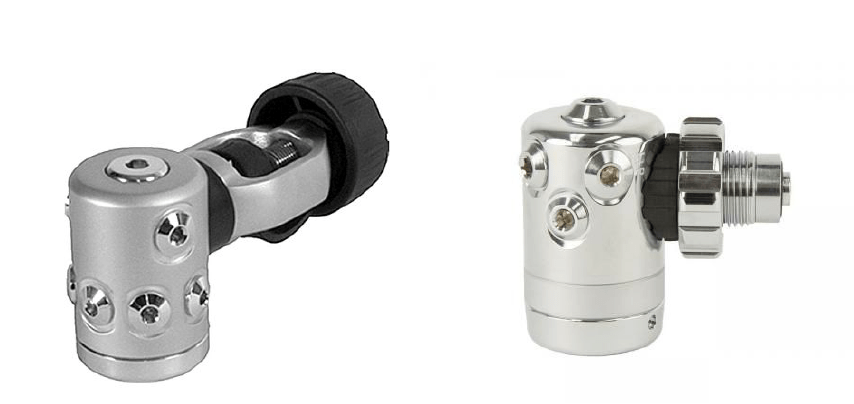
Most scuba regulators on the market today are available in both yoke (A-Clamp/International) or DIN connections. Until fairly recently, yoke ruled the seas. It was the only option on the market. However, in recent years, the DIN has come to the market, and has quickly become a favourite among many divers. The yoke connection is clamped onto the top of the cylinder valve opening, and is tightened via a screw at the end of the clamp. The O-ring is placed on the cylinder valve. Conversely, the DIN connection is screwed directly into the cylinder valve opening, with the O-ring being held on the thread of the first stage instead. These differences have consequences.
Firstly, the positioning of the O-ring on the DIN regulator is superior, as it is protected from external contaminants and damage, as well as being far less likely to fall out. Secondly, as the DIN regulator is screwed directly into the tank, it is far less likely to suffer damage and potentially fall off if it comes into contact with a surface, such as in an overhead environment. The yoke – in extreme situations – has the potential to be knocked fully off the cylinder as it is simply clamped on top of it, rather than screwed into it. Similarly, for overhead environments and for stage and sidemount tanks the DIN connection significantly reduces bulk, making for more streamlined setups. This in turn increases safety and ease of operation. On top of this, yoke regulators tend to be heavier than DIN, meaning that they are more negative in the water (consideration for sidemount divers) and that they put up the weight of your luggage (consideration for the travelling diver). One of the other primary benefits of DIN regulators is that they have increased pressure capacity, allowing fills of up to 300 bar compared to a maximum of 232 bar with yoke regulators. This is significant for technical divers wanting more litres of gas for longer, deeper dives, as well as for those diving in places where over-filled cylinders are commonplace.
The only benefit yoke carries over DIN is one of availability. In North America or Asia, yoke is more common than DIN. Therefore, you will need a Yoke-DIN adapter in order to connect your regulator to the cylinders. However, this is hardly a problem as most dive centres have adapters. On the other hand, the case is reversed in Europe, as DIN is most commonly used. Therefore, availability is hardly a good reason to opt for yoke over DIN.
That said, however, Yoke regulators are still very good regulators. As a consequence of the ‘DIN revolution’, some people have conflated DIN’s superior design with Yoke being a safety hazard. This is not the case. Millions of dives have been, and still are, carried out with Yoke regulators. The point to emphasise, however, is that DIN is always the better option.
Ports and Other Things…
A consideration sometimes overlooked in regulator selection is that of how many ports it has and the positioning of the ports.
The majority of regulators come with at least 4 low pressure ports and 1 high pressure port. The high pressure port is for the pressure gauge. This leaves 4 low pressure ports: one for the primary second stage, one for the secondary second stage, one for the low pressure inflator hose, and one for a drysuit inflator hose. However, if you dive with a transmitter, for example, this may present a problem. The majority of those diving with transmitters usually have a back-up normal pressure gauge. This requires two high pressure ports. Similarly, for those diving in sidemount, a 5th low pressure port is desirable for optimum hose routing, so that the hose can run directly to the chest inflator without any kinks or bends. Some scuba regulators also come with the option of a swivelling turret on the first stage, on which the low pressure ports are located. This allows for more flexibility in hose routing options, as well as less chance of unnecessary kinks in the hoses. However, it is not strictly necessary, and is usually only of real interest for sidemount and twinset divers.